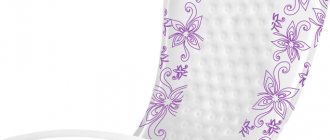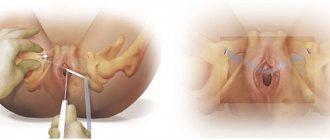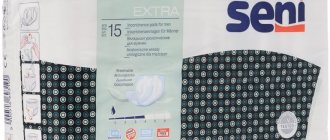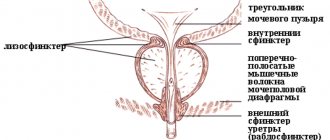Approximately every fifth woman in the Russian Federation faces the problem of urinary incontinence, and the older the woman, the more likely she is to develop symptoms of this pathology.
Despite the fact that urinary incontinence is widespread among the female population, patients rarely talk about symptoms at an appointment with a gynecologist or urologist, which is due to the delicacy of the problem and their reluctance to introduce strangers to the intimate sphere.
In the vast majority of cases, urinary incontinence can be successfully prevented and effectively treated. Today in urological practice there are many methods of conservative and surgical treatment that guarantee a long-term positive effect.
However, there are cases when drug treatment is ineffective, and surgical intervention is contraindicated due to the presence of severe concomitant pathology. In such cases, patients are advised to use urological pads as required.
The use of urological pads is recommended during the period from the start of therapy until a lasting clinical effect is obtained, in the postpartum period (if the pelvic floor muscles have been damaged), when treated with exercises aimed at strengthening the pelvic floor muscles.
How to choose urological pads for women
Up to 40% of the fairer sex, regardless of age, encounter various forms of urinary incontinence. Most often, the causes of the problem are various hormonal disorders, menopause and increased load on the pelvic organs during pregnancy and childbirth.
Usually the disorder is temporary and can be successfully treated with therapeutic correction, but it causes significant discomfort to patients. The use of special hygiene products designed to retain excreted urine helps improve the quality of life. Let's look at how to choose urological pads for women + a comparison table of the most popular products.
Difference between urological and conventional pads
The main mistake of most patients suffering from uncontrolled bladder emptying is the use of conventional pads for menstrual periods.
Compared to urine, menstrual discharge has a more viscous consistency and smaller volume, so the hygiene products intended for it differ not only in shape, but also in the composition of the absorbent layers.
Women who use them during incontinence note the rapid development of an unpleasant odor, the formation of lumps and frequent leaks.
Unlike conventional pads, urological hygiene products:
- instantly absorb the released liquid over the entire surface;
- have a top layer with antiseptic impregnation, which prevents the growth of bacteria and the appearance of an unpleasant odor;
- have an anatomical shape that is preserved even when very wet;
- equipped with additional protective elements against leakage (corrugated sides, elastic bands and cuffs);
- designed for less frequent changes (if the product is correctly selected according to the amount of liquid absorbed, the pad can be used for 4-7 hours).
Other benefits
For a long time, in urology, only bulky, uncomfortable diapers were used as a means of hygiene for incontinence, causing a lot of inconvenience to the patient. Now on pharmacy shelves you can find products with a thickness of only 3-5 mm, invisible under clothing and allowing active movements.
By analogy with conventional pads, they are securely attached to underwear using a wide adhesive layer. When using large-sized hygiene products that can absorb a significant amount of liquid in severe incontinence, elastic seamless panties are used for additional fixation.
All urological pads have a soft, breathable surface and do not contain latex or other components that can cause an allergic reaction.
The absorbent in the inner layer of the product has an acidic environment and reduces the pH of urine, due to which it not only inhibits the proliferation of pathogenic flora, but also prevents irritation on the skin and mucous membranes. Some hygiene products have an additional layer with medicinal impregnation to prevent inflammation of the female genital area.
Also, urinary pads with high absorption capacity are recommended for effective absorption of lochia - heavy bloody discharge that lasts several weeks after childbirth.
Pads, urological panties - what's the difference?
These hygiene products are very similar in function, but the main difference is in the shape of the finished product.
- Women's urinary pads have different absorbencies and differ in design (for different situations). The shape of the pad usually follows the shape of the body, and the size of the product is influenced by the degree of absorbency. This is a multi-layer product with the functions of odor neutralization, rapid absorption and absorption of secretions. All of them have an antibacterial layer. The pads have a protective edge along the edge (from leakage) and an adhesive base for better fixation with the laundry. The products are made from special dermatologically safe materials. Mainly used for self-monitoring, mild to moderate incontinence.
- Urological panties for women, disposable and reusable, are essentially a substitute for underwear, but have special absorbent properties. The hygiene product is selected according to size. It is used more often by people leading an active lifestyle. Disposable - throw away, reusable - suggest the possibility of washing. Recommended for moderate to severe incontinence.
Types of urological pads
All feminine hygiene products used in urology are divided into several types:
- By volume of absorbed liquid, depending on the degree of incontinence: up to 50 ml (drip form of incontinence);
- up to 100 ml (mild);
- up to 200 ml (medium level);
- up to 400-500 ml (severe urological disorders, enuresis).
- without additional protection (pads for drip incontinence);
- with a special absorbent layer;
Types and classification of products
Urological pads for women are no different in design from sanitary pads intended for menstrual flow, but have a wider adhesive strip to secure the product and additional protection against leakage.
Urological pads differ from each other in thickness and shape, which is directly proportional to the degree of their absorption. Each manufacturer always classifies products and develops a line specifically for its brand, however, some patterns in the classification can still be identified.
Among all types of urological pads, three large groups can be distinguished depending on the degree of absorption (maximum volume of absorbed liquid):
- 1 Ultrathin urological feminine pads practically do not differ in appearance from daily sanitary pads and are designed to absorb no more than 80 ml of urine. These types of pads are suitable for drip incontinence, for example, with. This line is usually called Micro or Ultramini (1 drop).
- 2 Thin - similar in appearance to sanitary pads for use during menstruation and are designed for a total absorption of no more than 300 ml of liquid. Urine absorption occurs quickly, and the thickness of this group of pads ranges from 3 to 5 mm. Such urological pads should be chosen for mild or mild-moderate incontinence. The names of thin urological pads include the words Mini, Midi, Normal (2 to 3 drops).
- 3 Large pads absorb significant volumes of liquid (up to 900 ml) and are suitable for severe forms of incontinence. The average thickness of such a gasket is about 13 mm. The design necessarily contains auxiliary elements to protect against leakage. The line is usually called Extra, Super, Plus, Maxi (4-6 drops). The Tena brand of urological pads has a slightly expanded product line, and it includes pads with maximum absorbency - Super (7 drops).
Although incontinence is the most common problem in women, men are also not immune to unpleasant symptoms. Urological pads designed for men, as a rule, look like a pocket that is attached from the inside to the underwear.
Figure 4 - Urological pads for men
This type of fastening allows you to avoid unnecessary discomfort and compression of the genitals. Men's pads are designed for mild to moderate incontinence and are equipped with leakage prevention features: wings and elastic fasteners on the sides.
Some manufacturers produce pads designed to attach to the penis, which makes them one of the most invisible.
Review of manufacturers
Currently, three manufacturers of urological pads have gained the most popularity:
- Seny (Seni), Poland;
- Tena (Tena), Switzerland;
- MoliMed (MoliMed), Germany.
Comparative characteristics of feminine hygiene products from the listed manufacturers, used for urinary incontinence, are given in the table:
| Brand | Name | Number of "drops" | Degree of incontinence | Size, cm | Quantity per package, pcs | Availability of additional protection | Short description | Use after childbirth |
| Seni (Seni) | Seni Lady Micro | 1 | Drip and light | 7,0*18,5 | 20 | No | Standard Absorbent Products | No |
| Seni Lady Mini | 2 | 9,5*22,5 | 20 | Hydrophobic sides on the sides | ||||
| Seni Lady Mini Plus | 2,5 | 10,0*25,5 | 20 | |||||
| Seni Lady Normal | 3 | 10,5*28,0 | 20 | Yes | ||||
| Seni Lady Extra | 4 | 15,0*28,0 | 20 | Hydrophobic sides with additional corrugation | ||||
| Tena | Tena Lady Ultra Mini | 1 | Drip and light | 19,0 | 14 or 28 | No | Standard Absorbent Products | No |
| Tena Lady Mini Wings | 2 | 22,0 | 18 | Wings | ||||
| Tena Lady Normal | 3 | 27,0 | 8, 12 or 24 | Wide elastic bands on the sides for extra support | ||||
| Tena Lady Extra | 4 | 34,0 | 10 or 20 | |||||
| Tena Lady Extra Plus | 5 | 34,0 | 8 | Yes | ||||
| Tena Lady Maxi | 5,5 | — | 6 | |||||
| Tena Lady Maxi Night | 6 | — | 6 | Wide elastic bands on the sides and extension at the bottom | Increased moisture absorption during sleep | |||
| MoliMed | MoliMed Thin | 1 | Drip, light and medium | 10,0*28,0 | 14 | No | Standard Absorbent Products | No |
| MoliMed Classic mini | 2 | 11,0*26,0 | 28 | |||||
| MoliMed Classic midi | 3 | 13,0*33,0 | 28 | |||||
| MoliMed Classic maxi | 4 | 16,0*43,0 | 28 | |||||
| MoliMed Sportive | — | 8,0*28,0 | 14 | Wings | Suitable for sports | |||
| MoliMed Premium ultra micro | 0,5 | — | 28 | No | Improved composition of absorbent layers | |||
| MoliMed Premium micro light | 1 | 10,0*22,0 | 14 | |||||
| MoliMed Premium micro | 1 | 10,0*27,0 | 14 | |||||
| MoliMed Premium mini | 2 | 11,0*26,0 | 14 | |||||
| MoliMed Premium midi | 3 | 13,0*33,0 | 14 | |||||
| MoliMed Premium maxi | 4 | 16,0*43,0 | 14 | |||||
| Samu | — | 12,5*33,0 | 10 | Sterile products | Yes |
10/08/2019 Few people know that many women, regardless of age, face such a delicate situation as bladder sensitivity. However, not everyone knows that there are special pads that effectively hide such intimate details from strangers.
When faced with incontinence for the first time, many women use ordinary sanitary pads, which they have been accustomed to since adolescence. But the fact is that such products are not designed to absorb urine, because menstrual fluid is more viscous and is absorbed gradually, while urine is released quickly and sometimes in significant volumes. Therefore, the absorbent layer of conventional sanitary pads is not as effective at absorbing and retaining liquid. Also, when using regular incontinence pads, an unwanted odor may appear, and this deprives self-confidence, limiting a woman’s active lifestyle.
To prevent incontinence from interfering with your plans, try urinary pads - for example, TENA Lady. They are specially designed for use with incontinence: the absorbent layer of such pads contains superabsorbent granules, quickly absorbs moisture and retains it inside the pad. And the anatomical shape, following the contours of the body, will provide a tight, comfortable fit to the body and protection from leaks.
High absorbency is not always a characteristic of thick pads. For example, the TENA Lady range includes ultra-thin pads TENA
Lady Ultra Mini
. Outwardly, they are similar to regular panty liners, but their absorbent layer contains a lot of superabsorbent, which turns the liquid into a gel. Being thin and discreet, this pad will absorb more moisture than a regular panty liner and will prevent the spread of odor.
Urological pads will also come in handy for young mothers after the birth of their baby. In the first days after childbirth, women experience heavy discharge - this is a natural process and one of the stages of recovery of the body after childbirth. During this period, a woman must carefully observe hygiene to avoid the risk of inflammatory diseases. For use in the postpartum period, super-absorbent pads TENA Lady Extra Plus
. In addition to their high absorbency, these pads have a special depression in the center that instantly absorbs liquid into the inner layers of the pad. The soft surface is pleasant to the touch and prevents irritation upon contact with delicate skin.
The TENA Lady line offers a wide range of pads - from compact ultra-thin to super-absorbent and night pads. This choice allows you to choose the most convenient and reliable product for any situation and lifestyle.
When choosing urological (absorbent) pads, proceed from the volume and frequency of urine output. In the TENA Lady assortment, the images of drops on the packaging will help you choose. For mild incontinence, it is recommended to start with thin pads TENA
Lady Slim Mini
, which are similar in size to regular pads for critical days, or with
TENA Lady Normal
if you need compact protection for heavier discharge.
Be yourself with TENA Lady!
Adviсe
To ensure that the use of urological pads does not cause discomfort, and the treatment of incontinence is more effective, the following recommendations must be followed:
- change hygiene products as needed, but at least once every 6-7 hours;
- every time you change a pad, take a warm shower using a pH-neutral cleanser and lubricate the skin folds with a protective cream to prevent irritation and diaper rash;
- consume a rational amount of fluid (drink as needed, avoiding dehydration);
- do not abuse diuretic products (cherries, watermelon, herbal teas);
- control your weight;
- monitor timely bowel movements;
- engage in moderate physical activity, do exercises to restore the elasticity of the pelvic floor muscles;
- observe the urination regime (visit the toilet 30-40 minutes after drinking).
Read
Also:
- How to choose pads for a teenage girl?
- How to choose and wear pads correctly?
- Gaskets with anion chip: are they needed and how do they work?
- Diapers for adults, which ones are better?
- Breast pads for breastfeeding
- TOP 7: Choosing pads for armpits against sweat, reviews. Instructions on how to make it yourself









